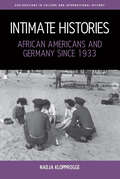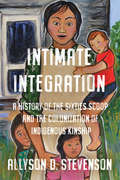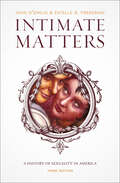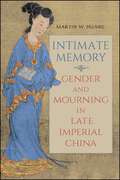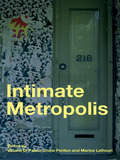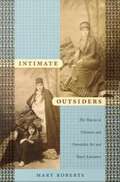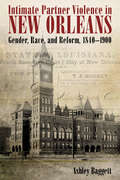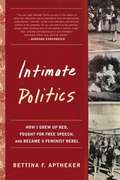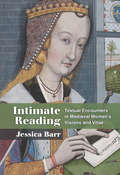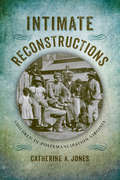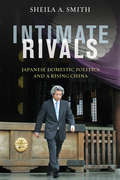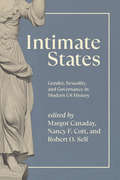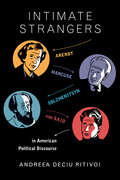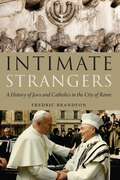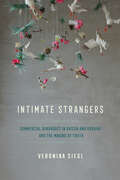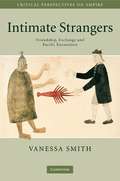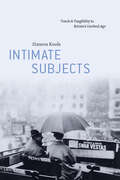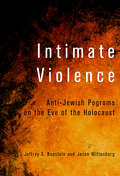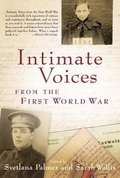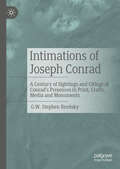- Table View
- List View
Intimate Histories: African Americans and Germany since 1933 (Explorations in Culture and International History #12)
by Nadja KlopproggeIntimate Histories focuses on intimate relations as sites of shared pasts connecting African American and German history in the years between 1933 and 1990. By tracing topics that include anti-miscegenation laws, forced sterilization, casual sexual encounters, marriage, and friendships, Intimate Histories broadens our understanding of African American–German relations during the so-called “century of extremes.”
Intimate Integration: A History of the Sixties Scoop and the Colonization of Indigenous Kinship (Studies in Gender and History)
by Allyson StevensonPrivileging Indigenous voices and experiences, Intimate Integration documents the rise and fall of North American transracial adoption projects, including the Adopt Indian and Métis Project and the Indian Adoption Project. Allyson D. Stevenson argues that the integration of adopted Indian and Métis children mirrored the new direction in post-war Indian policy and welfare services. She illustrates how the removal of Indigenous children from their families and communities took on increasing political and social urgency, contributing to what we now call the "Sixties Scoop." Making profound contributions to the history of settler colonialism in Canada, Intimate Integration sheds light on the complex reasons behind persistent social inequalities in child welfare.
Intimate Matters: A History of Sexuality in America
by John D'Emilio Estelle B. Freedman“Fascinating . . . chart[s] a gradual but decisive shift in the way Americans have understood sex and its meaning in their lives.” —New York Times Book ReviewThe first full length study of the history of sexuality in America, Intimate Matters offers trenchant insights into the sexual behavior of Americans, from colonial times to today. D’Emilio and Freedman give us a deeper understanding of how sexuality has dramatically influenced politics and culture throughout our history.“Intimate Matters was cited by Supreme Court Justice Anthony Kennedy when, writing for a majority of court on July 26, he and his colleagues struck down a Texas law criminalizing sodomy. The decision was widely hailed as a victory for gay rights. . . . The justice mentioned Intimate Matters specifically in the court’s decision.” —Chicago Tribune“With comprehensiveness and care . . . D’Emilio and Freedman have surveyed the sexual patterns for an entire nation across four centuries.” —Nation“Comprehensive, meticulous and intelligent.” —Washington Post Book World“This book is remarkable . . . [Intimate Matters] is bound to become the definitive survey of American sexual history for years to come.” —Roy Porter, Journal of the History of the Behavioral Sciences
Intimate Memory: Gender and Mourning in Late Imperial China (SUNY series in Chinese Philosophy and Culture)
by Martin W. HuangIn the first study of its kind about the role played by intimate memory in the mourning literature of late imperial China, Martin W. Huang focuses on the question of how men mourned and wrote about women to whom they were closely related. Drawing upon memoirs, epitaphs, biographies, litanies, and elegiac poems, Huang explores issues such as how intimacy shaped the ways in which bereaved male authors conceived of womanhood and how such conceptualizations were inevitably also acts of self-reflection about themselves as men. Their memorial writings reveal complicated self-images as husbands, brothers, sons, and educated Confucian males, while their representations of women are much more complex and diverse than the representations we find in more public genres such as Confucian female exemplar biographies.
Intimate Metropolis: Urban Subjects in the Modern City
by Vittoria Di Palma Diana Periton Marina LathouriIntimate Metropolis explores connections between the modern city, its architecture, and its citizens, by questioning traditional conceptualizations of public and private. Rather than focusing purely on public spaces—such as streets, cafés, gardens, or department stores—or on the domestic sphere, the book investigates those spaces and practices that engage both the urban and the domestic, the public and the private. The legal, political and administrative frameworks of urban life are seen as constituting private individuals’ sense of self, in a wide range of European and world cities from Amsterdam and Barcelona to London and Chicago. Providing authoritative new perspectives on individual citizenship as it relates to both public and private space, in-depth case studies of major European, American and other world cities and written by an international set of contributors, this volume is key reading for all students of architecture.
Intimate Outsiders: The Harem in Ottoman and Orientalist Art and Travel Literature
by Mary RobertsUntil now, the notion of a cross-cultural dialogue has not figured in the analysis of harem paintings, largely because the Western fantasy of the harem has been seen as the archetype for Western appropriation of the Orient. In Intimate Outsiders, the art historian Mary Roberts brings to light a body of harem imagery that was created through a dynamic process of cultural exchange. Roberts focuses on images produced by nineteenth-century European artists and writers who were granted access to harems in the urban centers of Istanbul and Cairo. As invited guests, these Europeans were "intimate outsiders" within the women's quarters of elite Ottoman households. At the same time, elite Ottoman women were offered intimate access to European culture through their contact with these foreign travelers. Roberts draws on a range of sources, including paintings, photographs, and travelogues discovered in archives in Britain, Turkey, Egypt, and Denmark. She rethinks the influential harem works of the realist painter John Frederick Lewis, a British artist living in Cairo during the 1840s, whose works were granted an authoritative status by his British public despite the actual limits of his insider knowledge. Unlike Lewis, British women were able to visit Ottoman harems, and from the mid-nineteenth century on they did so in droves. Writing about their experiences in published travelogues, they undermined the idea that harems were the subject only of male fantasies. The elite Ottoman women who orchestrated these visits often challenged their guests' misapprehensions about harem life, and a number of them exercised power as patrons, commissioning portraits from European artists. Their roles as art patrons defy the Western idea of the harem woman as passive odalisque.
Intimate Partner Violence in New Orleans: Gender, Race, and Reform, 1840-1900
by Ashley BaggettAshley Baggett uncovers the voices of abused women who utilized the legal system in New Orleans to address their grievances from the antebellum era to the end of the nineteenth century. Poring over 26,000 records, Baggett analyzes 421 criminal cases involving intimate partner violence—physical or emotional abuse of a partner in a romantic relationship—revealing a significant demand among women, the community, and the courts for reform in the postbellum decades. Before the Civil War, some challenges and limits to the male privilege of chastisement existed, but the gendered power structure and the veil of privacy for families in the courts largely shielded abusers from criminal prosecution. However, the war upended gender expectations and increased female autonomy, leading to the demand for and brief recognition of women's right to be free from violence. Baggett demonstrates how postbellum decades offered a fleeting opportunity for change before the gender and racial expectations hardened with the rise of Jim Crow. Her findings reveal previously unseen dimensions of women's lives both inside and outside legal marriage and women's attempts to renegotiate power in relationships. Highlighting the lived experiences of these women, Baggett tracks how gender, race, and location worked together to define and redefine gender expectations and legal rights. Moreover, she demonstrates recognition of women's legal personhood as well as differences between northern and southern states' trajectories in response to intimate partner violence during the nineteenth century.
Intimate Politics: How I Grew Up Red, Fought for Free Speech, and Became a Feminist Rebel
by Bettina F. ApthekerAt eight years old, Bettina Aptheker watched her family's politics play out in countless living rooms across the country when her father, historian and U. S. Communist Party leader Herbert Aptheker, testified on television in front of the House Un-American Activities Committee in 1953. Born into one of the most influential U. S. Communist families whose friends included W. E. B. Du Bois, Paul Robeson, and Elizabeth Gurley Flynn, Bettina lived her parents' politics witnessing first-hand one of the most dramatic upheavals in American history. She also lived with a terrible secret: incest at the hands of her famous father and a frightening and lonely life lived inside a home wrought with family tensions. Includes photos with captions.
Intimate Reading: Textual Encounters in Medieval Women’s Visions and Vitae
by Jessica BarrIntimate Reading: Textual Encounters in Medieval Women’s Visions and Vitae explores the ways that women mystics sought to make their books into vehicles for the reader’s spiritual transformation. Jessica Barr argues that the cognitive work of reading these texts was meant to stimulate intensely personal responses, and that the very materiality of the book can produce an intimate encounter with God. She thus explores the differences between mystics’ biographies and their self-presentation, analyzing as well the complex rhetorical moves that medieval women writers employ to render their accounts more effective. This new volume is structured around five case studies. Chapters consider the biographies of 13th-century holy women from Liège, the writings of Margery Kempe, Gertrude of Helfta, Mechthild of Magdeburg, Marguerite Porete, and Julian of Norwich. At the heart of Intimate Reading is the question of how reading works—what it means to enter imaginatively and intellectually into the words of another. The volume showcases the complexity of medieval understandings of the work of reading, deepening our perception of the written word’s capacity to signify something that lies even beyond rational comprehension.
Intimate Reconstructions: Children in Postemancipation Virginia (A Nation Divided: Studies in the Civil War Era)
by Catherine A. JonesIn Intimate Reconstructions, Catherine Jones considers how children shaped, and were shaped by, Virginia's Reconstruction. Jones argues that questions of how to define, treat, reform, or protect children were never far from the surface of public debate and private concern in post-Civil War Virginia. Through careful examination of governmental, institutional, and private records, the author traces the unpredictable paths black and white children traveled through this tumultuous period. Putting children at the center of the narrative reveals the unevenness of the transitions that defined Virginia in the wake of the Civil War: from slavery to freedom, from war to peace, and from secession to a restored but fractured union. While some children emerged from the war under the protection of families, others navigated treacherous circumstances on their own. The reconfiguration of postwar households, and disputes over children's roles within them, fueled broader debates over public obligations to protect all children. The reorganization of domestic life was a critical proving ground for Reconstruction. Freedpeople's efforts to recover children strained against white Virginians' efforts to retain privileges formerly undergirded by slavery. At the same time, orphaned children, particularly those who populated the streets of Virginia's cities, prompted contentious debate over who had responsibility for their care, as well as rights to their labor. By revisiting conflicts over the practices of orphan asylums, apprenticeship, and adoption, Intimate Reconstructions demonstrates that race continued to shape children's postwar lives in decisive ways. In private and public, children were at the heart of Virginians' struggles over the meanings of emancipation and Confederate defeat.
Intimate Rivals
by Sheila A. SmithThe first in-depth analysis of the geostrategic change that has reshaped Japan's social and political relationship with China.
Intimate States: Gender, Sexuality, and Governance in Modern US History
by Nancy F. Cott Margot Canaday Robert O. SelfFourteen essays examine the unexpected relationships between government power and intimate life in the last 150 years of United States history. The last few decades have seen a surge of historical scholarship that analyzes state power and expands our understanding of governmental authority and the ways we experience it. At the same time, studies of the history of intimate life—marriage, sexuality, child-rearing, and family—also have blossomed. Yet these two literatures have not been considered together in a sustained way. This book, edited and introduced by three preeminent American historians, aims to close this gap, offering powerful analyses of the relationship between state power and intimate experience in the United States from the Civil War to the present. The fourteen essays that make up Intimate States argue that “intimate governance”—the binding of private daily experience to the apparatus of the state—should be central to our understanding of modern American history. Our personal experiences have been controlled and arranged by the state in ways we often don’t even see, the authors and editors argue; correspondingly, contemporary government has been profoundly shaped by its approaches and responses to the contours of intimate life, and its power has become so deeply embedded into daily social life that it is largely indistinguishable from society itself. Intimate States makes a persuasive case that the state is always with us, even in our most seemingly private moments.
Intimate States: Gender, Sexuality, and Governance in Modern US History
by Nancy F. Cott Margot Canaday Robert O. SelfFourteen essays examine the unexpected relationships between government power and intimate life in the last 150 years of United States history. The last few decades have seen a surge of historical scholarship that analyzes state power and expands our understanding of governmental authority and the ways we experience it. At the same time, studies of the history of intimate life—marriage, sexuality, child-rearing, and family—also have blossomed. Yet these two literatures have not been considered together in a sustained way. This book, edited and introduced by three preeminent American historians, aims to close this gap, offering powerful analyses of the relationship between state power and intimate experience in the United States from the Civil War to the present. The fourteen essays that make up Intimate States argue that “intimate governance”—the binding of private daily experience to the apparatus of the state—should be central to our understanding of modern American history. Our personal experiences have been controlled and arranged by the state in ways we often don’t even see, the authors and editors argue; correspondingly, contemporary government has been profoundly shaped by its approaches and responses to the contours of intimate life, and its power has become so deeply embedded into daily social life that it is largely indistinguishable from society itself. Intimate States makes a persuasive case that the state is always with us, even in our most seemingly private moments.
Intimate States: Gender, Sexuality, and Governance in Modern US History
by Nancy F. Cott Margot Canaday Robert O. SelfFourteen essays examine the unexpected relationships between government power and intimate life in the last 150 years of United States history. The last few decades have seen a surge of historical scholarship that analyzes state power and expands our understanding of governmental authority and the ways we experience it. At the same time, studies of the history of intimate life—marriage, sexuality, child-rearing, and family—also have blossomed. Yet these two literatures have not been considered together in a sustained way. This book, edited and introduced by three preeminent American historians, aims to close this gap, offering powerful analyses of the relationship between state power and intimate experience in the United States from the Civil War to the present. The fourteen essays that make up Intimate States argue that “intimate governance”—the binding of private daily experience to the apparatus of the state—should be central to our understanding of modern American history. Our personal experiences have been controlled and arranged by the state in ways we often don’t even see, the authors and editors argue; correspondingly, contemporary government has been profoundly shaped by its approaches and responses to the contours of intimate life, and its power has become so deeply embedded into daily social life that it is largely indistinguishable from society itself. Intimate States makes a persuasive case that the state is always with us, even in our most seemingly private moments.
Intimate Strangers
by Andreea Deciu RitivoiAndreea Deciu Ritivoi is professor of English at Carnegie Mellon University. Her research focuses on immigration, exile, political discourse, argumentation theory, and intellectual history. She is the author of Yesterday's Self: Nostalgia and the Immigrant Identity and Paul Ricoeur: Tradition and Innovation in Rhetorical Theory.
Intimate Strangers: A History of Jews and Catholics in the City of Rome
by Fredric BrandfonThe Jewish community of Rome is the oldest Jewish community in Europe. It is also the Jewish community with the longest continuous history, having avoided interruptions, expulsions, and annihilations since 139 BCE. For most of that time, Jewish Romans have lived in close contact with the largest continuously functioning international organization: the Roman Catholic Church. Given the church&’s origins in Judaism, Jews and Catholics have spent two thousand years negotiating a necessary and paradoxical relationship. With engaging stories that illuminate the history of Jews and Jewish-Catholic relations in Rome, Intimate Strangers investigates the unusual relationship between Jews and Catholics as it has developed from the first century CE to the present in the Eternal City. Fredric Brandfon innovatively frames these relations through an anthropological lens: how the idea and language of family have shaped the self-understanding of both Roman Jews and Catholics. The familial relations are lopsided, the powerful family member often persecuting the weaker one; the church ghettoized the Jews of Rome longer than any other community in Europe. Yet respect and support are also part of the family dynamic—for instance, church members and institutions protected Rome&’s Jews during the Nazi occupation—and so the relationship continues. Brandfon begins by examining the Arch of Titus and the Jewish catacombs as touchstones, painting a picture of a Jewish community remaining Jewish over centuries. Papal processions and the humiliating races at Carnival time exemplify Jewish interactions with the predominant Catholic powers in medieval and Renaissance Rome. The Roman Ghetto, the forcible conversion of Jews, emancipation from the Ghetto in light of Italian nationalism, the horrors of fascism and the Nazi occupation in Rome, the Second Vatican Council proclamation absolving Jews of murdering Christ, and the celebration of Israel&’s birth at the Arch of Titus are interwoven with Jewish stories of daily life through the centuries. Intimate Strangers takes us on a compelling sweep of two thousand years of history through the present successes and dilemmas of Roman Jews in postwar Europe.
Intimate Strangers: Arendt, Marcuse, Solzhenitsyn, and Said in American Political Discourse
by Andreea Deciu RitivoiAndreea Deciu Ritivoi is professor of English at Carnegie Mellon University. Her research focuses on immigration, exile, political discourse, argumentation theory, and intellectual history. She is the author of Yesterday's Self: Nostalgia and the Immigrant Identity and Paul Ricoeur: Tradition and Innovation in Rhetorical Theory.
Intimate Strangers: Arendt, Marcuse, Solzhenitsyn, and Said in American Political Discourse
by Andreea Deciu RitivoiAndreea Deciu Ritivoi is professor of English at Carnegie Mellon University. Her research focuses on immigration, exile, political discourse, argumentation theory, and intellectual history. She is the author of Yesterday's Self: Nostalgia and the Immigrant Identity and Paul Ricoeur: Tradition and Innovation in Rhetorical Theory.
Intimate Strangers: Arendt, Marcuse, Solzhenitsyn, and Said in American Political Discourse
by Andreea RitivoiHannah Arendt, Herbert Marcuse, Alexander Solzhenitsyn, and Edward Said each steered major intellectual and political schools of thought in American political discourse after World War II, yet none of them was American, which proved crucial to their ways of arguing and reasoning both in and out of the American context. In an effort to convince their audiences they were American enough, these thinkers deployed deft rhetorical strategies that made their cosmopolitanism feel acceptable, inspiring radical new approaches to longstanding problems in American politics. Speaking like natives, they also exploited their foreignness to entice listeners to embrace alternative modes of thought. Intimate Strangers unpacks this "stranger ethos," a blend of detachment and involvement that manifested in the persona of a prophet for Solzhenitsyn, an impartial observer for Arendt, a mentor for Marcuse, and a victim for Said. Yet despite its many successes, the stranger ethos did alienate many audiences, and critics continue to dismiss these thinkers not for their positions but because of their foreign point of view. This book encourages readers to reject this kind of critical xenophobia, throwing support behind a political discourse that accounts for the ideals of citizens and noncitizens alike.
Intimate Strangers: Commercial Surrogacy in Russia and Ukraine and the Making of Truth
by Veronika SieglZooming in on commercial surrogacy in Russia and Ukraine, Intimate Strangers addresses market expansion into the intimate spheres of life that play out on women's bodies as mothers and workers. Veronika Siegl follows the inner workings of a surrogacy market marked by secrecy, distrust, and anonymous business relationships. She explores intended mothers' anxious struggles for a child in light of stigmatized infertility and the aggressive biopolitics of motherhood; the uncertain but pragmatic pathways in and out of fertility clinics as surrogates navigate harsh economic realities and resist being objectified or morally judged; and the powerful role of agents and doctors who have found a profitable niche in nurturing and facilitating other people's existential hopes. Intimate Strangers discusses these issues against the backdrop of ultra-conservatism and moral governance in Russia, the rising international popularity of the Ukrainian surrogacy market, and the pervasiveness of neo-liberal ideologies and individualized notions of reproductive freedom.
Intimate Strangers: Friendship, Exchange and Pacific Encounters
by Vanessa SmithWhen Louis Antoine de Bougainville reached Tahiti in 1768, he was struck by the way in which 'All these people came crying out tayo, which means friend, and gave a thousand signs of friendship; they all asked nails and ear-rings of us.' Reading the archive of early contact in Oceania against European traditions of thinking about intimacy and exchange, Vanessa Smith illuminates the traditions and desires that led Bougainville and other European voyagers to believe that the first word they heard in the Pacific was the word for friend. Her book encompasses forty years of encounters from the arrival of the Dolphin in Tahiti in June 1767, through Cook's and Bligh's voyages, to early missionary and beachcomber settlement in the Marquesas. It unpacks both the political and emotional significances of ideas of friendship for late eighteenth-century European, and particularly British, explorations of Oceania.
Intimate Subjects: Touch and Tangibility in Britain's Cerebral Age
by Simeon KooleAn insightful history of nineteenth- and twentieth-century Britain told through a single sense: touch. When, where, and who gets to touch and be touched, and who decides? What do we learn through touch? How does touch bring us closer together or push us apart? These are urgent contemporary questions, but they have their origins in late nineteenth- and early twentieth-century Britain, when new urban encounters compelled intense discussion of what touch was, and why it mattered. In this vividly written book, Simeon Koole excavates the history of these concerns and reveals how they continue to shape ideas about “touch” in the present. Intimate Subjects takes us to the bustling railway stations, shady massage parlors, all-night coffee stalls, and other shared spaces where passengers, customers, vagrants, and others came into contact, leading to new understandings of touch. We travel in crammed subway cars, where strangers negotiated the boundaries of personal space. We visit tea shops where waitresses made difficult choices about autonomy and consent. We enter classrooms in which teachers wondered whether blind children could truly grasp the world and labs in which neurologists experimented on themselves and others to unlock the secrets of touch. We tiptoe through London’s ink-black fogs, in which disoriented travelers became newly conscious of their bodies and feared being accosted by criminals. Across myriad forgotten encounters such as these, Koole shows, touch remade what it meant to be embodied—as well as the meanings of disability, personal boundaries, and scientific knowledge. With imagination and verve, Intimate Subjects offers a new way of theorizing the body and the senses, as well as a new way of thinking about embodiment and vulnerability today.
Intimate Violence: Anti-Jewish Pogroms on the Eve of the Holocaust
by Jeffrey S. Kopstein Jason WittenbergWhy do pogroms occur in some localities and not in others? Jeffrey S. Kopstein and Jason Wittenberg examine a particularly brutal wave of violence that occurred across hundreds of predominantly Polish and Ukrainian communities in the aftermath of the Nazi invasion of the Soviet Union. The authors note that while some communities erupted in anti-Jewish violence, most others remained quiescent. In fact, fewer than 10 percent of communities saw pogroms in 1941, and most ordinary gentiles never attacked Jews.Intimate Violence is a novel social-scientific explanation of ethnic violence and the Holocaust. It locates the roots of violence in efforts to maintain Polish and Ukrainian dominance rather than in anti-Semitic hatred or revenge for communism. In doing so, it cuts through painful debates about relative victimhood that are driven more by metaphysical beliefs in Jewish culpability than empirical evidence of perpetrators and victims. Pogroms, they conclude, were difficult to start, and local conditions in most places prevented their outbreak despite a general anti-Semitism and the collapse of the central state. Kopstein and Wittenberg shed new light on the sources of mass ethnic violence and the ways in which such gruesome acts might be avoided.
Intimate Voices from the First World War
by Sarah Wallis Svetlana PalmerIn the tradition of the work of Studs Turkel and Ken Burns' "The Civil War," this book is the companion volume to a major television series--a compelling, personal account of World War I and its devastating aftermath. Photos & maps throughout.
Intimations of Joseph Conrad: A Century of Sightings and Citings of Conrad’s Presences in Print, Crafts, Media and Monuments
by G.W. Stephen BrodskyMaster mariner and pioneer author of Modernist technique Joseph Conrad (1857-1924) achieved such eminence in his lifetime that his presence, explicit or implicit, could be found in the lives and works of several contemporaries of consequence. Through the century since his death he has lived on as a presence in the works of later authors to the present day. A collection spanning fifteen years of the present author’s sightings of Conrad’s presences are not only literary, but also memorial. Monuments, sculpture, ships, plaques, the performing arts, cabinetry and even a pub find a place. Each sighting is described in its context—a couple of certain or likely sightings by Conrad, such as Molière and Matthew Arnold, and the rest sightings or ambient intimations of Conrad’s presence –fiction and social commentary in novels and film by significant authors who carry on his legacy, from contemporaries such as H.G. Wells, Ford Madox Ford and F. Scott Fitzgerald to moderns George Orwell, Albert Camus, John Le Carrée, Ian MacEwan and John Banfield, among others. Presented in a clear yet poetic prose style, this record of Conrad’s influence on these contemporary and later writers brings a significant dimension to their interpretation; conversely Conrad’s place may be perceived more precisely in the historically broadening canon from Modernist to Postmodern. Together with its illustrations, Intimations of Joseph Conrad is a novel and unique concept, as entertaining as it is informative.
